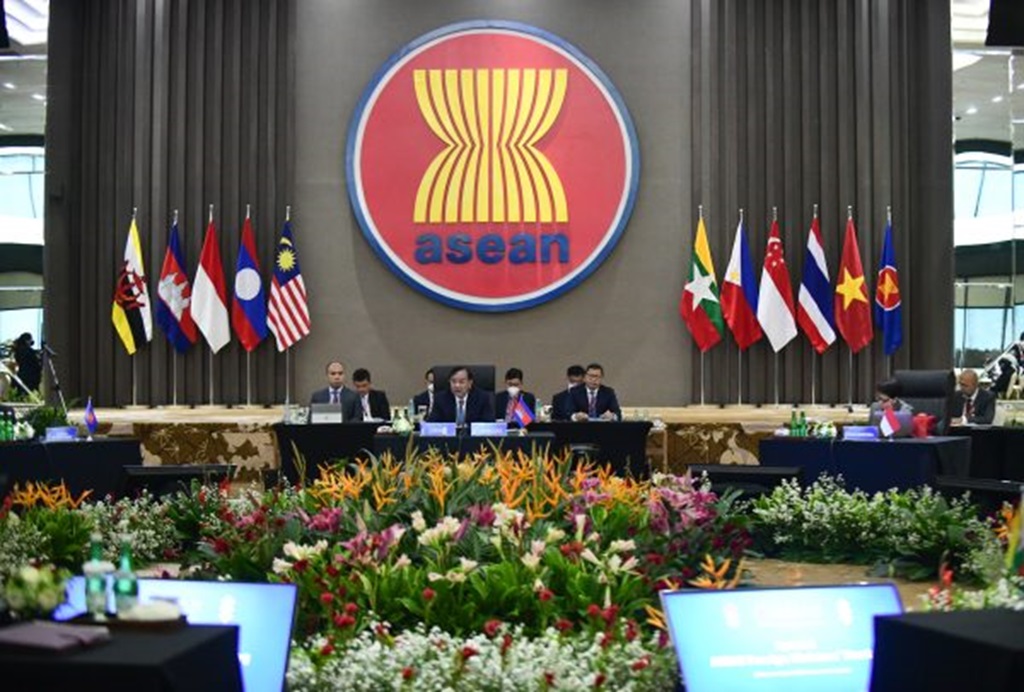ASEAN
Thailand Hosts ASEAN Defence Ministers Meeting
BANGKOK – Defence ministers from the Association of Southeast Asian Nations (ASEAN) have begun their annual meeting, over security threats, the South China Sea and North Korea high on the agenda.
Defence Ministry spokesman Kongcheep Tantrawanich said the 10 ministers are discussing both internal security cooperation and regional issues, especially cooperation in tackling security threats and combating terrorism.
The Bangkok Post reports that the ministers were set to adopt the terms of references tied to the “Our Eyes” initiative for sharing strategic information on terrorism and other non-traditional security threats.
Mr Kongcheep said the South China Sea row is high on the agenda as it affects regional stability and some members were involved in the dispute.
According to a draft of the joint declaration expected to be issued after the meeting, the ministers will reaffirm their stance calling on concerned parties to solve the sea dispute with peaceful means under international law.
The North Korea issue will also be raised since Asea hopes for a further easing of tensions on the peninsula following the latest summit between the US President Donald Trump and North Korean leader Kim Jong Un, according to the spokesman.
The 10 Asean countries are Brunei, Cambodia, Indonesia, Laos, Philippines, Malaysia, Myanmar, Thailand, Singapore and Vietnam.
ASEAN History
The Association of Southeast Asian Nations, was established on 8 August 1967 in Bangkok, Thailand.
The signing of the ASEAN Declaration by the Founding Fathers of ASEAN, namely Indonesia, Malaysia, Philippines, Singapore and Thailand.
Brunei then joined on 7 January 1984, Vietnam on 28 July 1995, Lao PDR and Myanmar on 23 July 1997, and Cambodia on 30 April 1999, making up what is today the ten Member States of ASEAN.
ASEAN
Thailand Touts Peace Plan With ASEAN Partners for Myanmar

Thailand has urged that three or more ASEAN member countries collaborate to engage with Myanmar’s military regime in order to alleviate the crisis and bring peace to the conflict-torn country, while keeping steadfast in its commitment to humanitarian aid and peace promotion.
Foreign Affairs Ministry spokesman Nikorndej Balankura said on Wednesday that Thailand had coordinated with Laos, the current Asean chair, to arrange what it terms Asean “Troika” and “Troika plus” talks to restore peace in Myanmar.
The Asean Troika is a community of foreign ministers from the bloc’s previous, current, and prospective chair countries [Indonesia, Laos, and Malaysia]. The term “plus” refers to other Asean members who are interested in promoting peace or concerned about the problem.
Mr Nikorndej stated that the proposed meetings are most likely to take place in Thailand and restated the country’s willingness to mediate negotiations between Myanmar’s junta and resistance organizations.
He stated that the ongoing violence is not between Thailand and Myanmar, and that the Thai government will provide humanitarian assistance to all groups affected by the fighting in accordance with national security, international relations, and human rights standards.
He emphasized that the crisis impacts all countries, including Thailand, which shares a border with Myanmar.
“Thailand is a peace advocate, thus we must stress our role as an active promoter of peace. This is evident in our willingness to mediate negotiations between Myanmar’s conflicting parties. “If they agree, we’re ready,” he stated.
Border Trade Resumes
According to Mr Nikorndej, because the majority of the refugees have returned to Myanmar, the situation is not considered severe, and the consequences on Thailand are limited, affecting border trade only temporarily.
The government committee overseeing the situation along the Thai-Myanmar border, chaired by Deputy Prime Minister and Foreign Minister Parnpree Bahiddha-Nukara, is considering forming sub-committees with the National Security Council (NSC) to make the selections.
He highlighted that the situation along the Thai-Myanmar border has improved over the last 48 hours, with no reports of firing from locals. However, the committee will keep an eye on the situation, which is fluid.
During Mr Parnpree’s visit to Tak’s Mae Sot area on Tuesday afternoon, he stated that there has been no fighting at the 2nd Thailand-Myanmar Friendship Bridge since Sunday, and the majority of the refugees who left the fighting over the weekend have since returned.
He stated that the most important thing is that Thai residents be reassured that the government is taking steps to alleviate the effects of the Myanmar conflict on their livelihoods.
“Our agencies have response plans and people can rest assured that we are giving top priority to their safety,” he went on to say. When asked when the Mae Sot checks will reopen, he said they are expected to do so soon because both sides in Myanmar understand the importance of the 2nd Thai-Myanmar Friendship Bridge as a crucial border commerce route.
Residents Return to Myanmar
Meanwhile, the final group of 658 Myanmar refugees who sought safety in Mae Sot on Wednesday voluntarily chose to return once the situation in Myawaddy eased, according to local officials.
They were provided needs, such as medicines, before crossing the Moei River back to Myawaddy. Local officials and charity workers escorted them away.
According to the most recent reports, the checkpoint at the 1st Thai-Myanmar Friendship Bridge reopened on Wednesday, and junta troops who had fled to the 2nd Thai-Myanmar Friendship Bridge had returned to their barracks at the 275th Infantry Battalion.
On Wednesday, Reuters reported that a Myanmar rebel force has evacuated from Myawaddy following a military counteroffensive.
According to a spokesman for the Karen National Union (KNU), the “temporary retreat” from the town of Myawaddy occurred after junta soldiers returned to the crucial strategic location, which serves as a conduit for more than $1 billion in yearly foreign trade.
ASEAN’s Influence Over Myanmar
ASEAN, or the Association of Southeast Asian Nations, is a regional intergovernmental organization made up of ten Southeast Asian countries. Founded in 1967, its mission is to foster economic, political, and social cooperation among its members. These countries are Brunei, Cambodia, Indonesia, Laos, Malaysia, Myanmar, the Philippines, Singapore, Thailand, and Vietnam.
ASEAN plays an important influence in the area. It promotes economic integration through initiatives such as the ASEAN Economic Community, which improve trade and investment flows. The group also addresses security, climate change, and human rights. It has tried to create a single market, promote sustainable growth, and deepen ties with its international partners.
Despite obstacles such as managing divergent interests, ASEAN remains influential. Its combined market of approximately 650 million people, as well as its strategic location between India and China, lend it economic weight. The group’s goal is to maintain regional stability while furthering its members’ common interests on the global stage.
ASEAN
Thailand Touts Peace Plan With ASEAN Partners for Myanmar

Thailand has urged that three or more ASEAN member countries collaborate to engage with Myanmar’s military regime in order to alleviate the crisis and bring peace to the conflict-torn country, while keeping steadfast in its commitment to humanitarian aid and peace promotion.
Foreign Affairs Ministry spokesman Nikorndej Balankura said on Wednesday that Thailand had coordinated with Laos, the current Asean chair, to arrange what it terms Asean “Troika” and “Troika plus” talks to restore peace in Myanmar.
The Asean Troika is a community of foreign ministers from the bloc’s previous, current, and prospective chair countries [Indonesia, Laos, and Malaysia]. The term “plus” refers to other Asean members who are interested in promoting peace or concerned about the problem.
Mr Nikorndej stated that the proposed meetings are most likely to take place in Thailand and restated the country’s willingness to mediate negotiations between Myanmar’s junta and resistance organizations.
He stated that the ongoing violence is not between Thailand and Myanmar, and that the Thai government will provide humanitarian assistance to all groups affected by the fighting in accordance with national security, international relations, and human rights standards.
He emphasized that the crisis impacts all countries, including Thailand, which shares a border with Myanmar.
“Thailand is a peace advocate, thus we must stress our role as an active promoter of peace. This is evident in our willingness to mediate negotiations between Myanmar’s conflicting parties. “If they agree, we’re ready,” he stated.
Border Trade Resumes
According to Mr Nikorndej, because the majority of the refugees have returned to Myanmar, the situation is not considered severe, and the consequences on Thailand are limited, affecting border trade only temporarily.
The government committee overseeing the situation along the Thai-Myanmar border, chaired by Deputy Prime Minister and Foreign Minister Parnpree Bahiddha-Nukara, is considering forming sub-committees with the National Security Council (NSC) to make the selections.
He highlighted that the situation along the Thai-Myanmar border has improved over the last 48 hours, with no reports of firing from locals. However, the committee will keep an eye on the situation, which is fluid.
During Mr Parnpree’s visit to Tak’s Mae Sot area on Tuesday afternoon, he stated that there has been no fighting at the 2nd Thailand-Myanmar Friendship Bridge since Sunday, and the majority of the refugees who left the fighting over the weekend have since returned.
He stated that the most important thing is that Thai residents be reassured that the government is taking steps to alleviate the effects of the Myanmar conflict on their livelihoods.
“Our agencies have response plans and people can rest assured that we are giving top priority to their safety,” he went on to say. When asked when the Mae Sot checks will reopen, he said they are expected to do so soon because both sides in Myanmar understand the importance of the 2nd Thai-Myanmar Friendship Bridge as a crucial border commerce route.
Residents Return to Myanmar
Meanwhile, the final group of 658 Myanmar refugees who sought safety in Mae Sot on Wednesday voluntarily chose to return once the situation in Myawaddy eased, according to local officials.
They were provided needs, such as medicines, before crossing the Moei River back to Myawaddy. Local officials and charity workers escorted them away.
According to the most recent reports, the checkpoint at the 1st Thai-Myanmar Friendship Bridge reopened on Wednesday, and junta troops who had fled to the 2nd Thai-Myanmar Friendship Bridge had returned to their barracks at the 275th Infantry Battalion.
On Wednesday, Reuters reported that a Myanmar rebel force has evacuated from Myawaddy following a military counteroffensive.
According to a spokesman for the Karen National Union (KNU), the “temporary retreat” from the town of Myawaddy occurred after junta soldiers returned to the crucial strategic location, which serves as a conduit for more than $1 billion in yearly foreign trade.
ASEAN’s Influence Over Myanmar
ASEAN, or the Association of Southeast Asian Nations, is a regional intergovernmental organization made up of ten Southeast Asian countries. Founded in 1967, its mission is to foster economic, political, and social cooperation among its members. These countries are Brunei, Cambodia, Indonesia, Laos, Malaysia, Myanmar, the Philippines, Singapore, Thailand, and Vietnam.
ASEAN plays an important influence in the area. It promotes economic integration through initiatives such as the ASEAN Economic Community, which improve trade and investment flows. The group also addresses security, climate change, and human rights. It has tried to create a single market, promote sustainable growth, and deepen ties with its international partners.
Despite obstacles such as managing divergent interests, ASEAN remains influential. Its combined market of approximately 650 million people, as well as its strategic location between India and China, lend it economic weight. The group’s goal is to maintain regional stability while furthering its members’ common interests on the global stage.
ASEAN
7 key things Changed for Indian Stock market Overnight – Gift Nifty, tech stocks rally to oil prices

(CTN News) – Indian stock market: The domestic equity market is projected to open lower on Tuesday, mirroring mixed global market cues ahead of global central banks’ monetary policy meetings.
Asian markets fell as US stock indices closed higher overnight, boosted by mega-cap growth stocks.
For additional interest rate clues, market investors will look to the Bank of Japan’s monetary policy choices later today and the US Federal Reserve’s policy this week. On Monday, the Indian stock market indices finished the turbulent day higher, powered by key metals and auto giants.
The Sensex rose 104.99 points, or 0.14%, to close at 72,748.42, while the Nifty 50 advanced 32.35 points, or 0.15%, to 22,055.70. “We expect the markets to consolidate in the coming days, while the broader market may remain subdued,” said Siddhartha Khemka, Head of Retail Research at Motilal Oswal Financial Services Ltd.
Here are significant worldwide market indications for the Sensex today:
Asian marketplaces
Asian markets fell on Tuesday ahead of the Bank of Japan’s monetary policy decision. After 17 years of negative interest rate policy, the Bank of Japan will likely cease it.
Japan’s Nikkei 225 lost 0.5% at the outset, while the Topix remained steady. South Korea’s Kospi fell 0.8%, while the Kosdaq dropped 0.4%. Hong Kong’s Hang Seng index futures showed a dismal start.
Gift Nifty Today
Today, the Gift Nifty was trading at 22,060, a markdown of nearly 70 points from the previous close of the Nifty futures. This indicates a gap-down start for Indian stock market indices.
US stock market indices closed higher on Monday, powered by mega cap growth stocks, as investors awaited the Federal Reserve’s policy meeting this week.
The Dow Jones Industrial Average rose 75.66 points, or 0.20%, to 38,790.43, while the S&P 500 increased 32.33 points, or 0.63%, to 5,149.42. The Nasdaq Composite closed 130.27 points, or 0.82% higher, at 16,103.45.
Tesla shares rose 6.3%, while Nvidia shares rose 0.7%. Xpeng’s US-listed shares rose 1.9%, Boeing’s stock price fell 1.5% and Super Micro Computer’s stock dropped 6.4%.
On Monday, technology megacap stocks in the US soared, with the Nasdaq 100 gaining about 1% and the ‘Magnificent Seven’ tech megacaps rising twice as much.
Google’s parent Alphabet shares rose 4.4% after Bloomberg News reported that Apple Inc. is discussing incorporating Google’s Gemini artificial intelligence engine inside the iPhone. Apple shares rose 0.6%.
Nvidia’s stock price jumped 0.7% after CEO Jensen Huang unveiled new chips to extend the company’s supremacy in AI computing. Tesla shares rose 6.3% after the electric carmaker announced that it would shortly raise the price of its Model Y EVs in areas of Europe.
Indian stock market Oil Prices:
Crude oil prices rose further following Ukrainian drone assaults on Russian refineries and OPEC supply cutbacks. Brent crude, the global standard, rose 0.06% to $86.94 per barrel after rallying 1.8% on Monday to its highest closing since late October. West Texas Intermediate was trading 0.06% higher at $82.77.
Bank of Japan
The Bank of Japan is anticipated to abandon its eight-year negative interest rate policy on Tuesday and raise interest rates for the first time in 17 years. If the nine-member board deems the conditions are right, the BOJ will set the overnight call rate as its new objective and guide it in a range of 0-0.1% by paying 0.1% interest on excess reserves held by financial institutions at the central bank, according to Reuters.
Japan’s 10-year government bond rate increased by one basis point (bp) to 0.765%, while the two-year yield increased by one bp to 0.19%.
US Treasury Yields
The benchmark US 10-year Treasury yields rose to three-week highs on Monday, ahead of the Federal Reserve’s meeting this week. The yield on 10-year notes reached 4.348%, up nearly 5 basis points on the day and the highest since February 23. According to Reuters, two-year yields rose to 4.751%, the highest level since February 23. The yield curve inversion between two-year and ten-year notes narrowed by 2 basis points to minus 40.
Related CTN News:
-

 News3 years ago
News3 years agoLet’s Know About Ultra High Net Worth Individual
-
Entertainment1 year ago
Mabelle Prior: The Voice of Hope, Resilience, and Diversity Inspiring Generations
-

 Health3 years ago
Health3 years agoHow Much Ivermectin Should You Take?
-

 Tech1 year ago
Tech1 year agoTop Forex Brokers of 2023: Reviews and Analysis for Successful Trading
-

 Lifestyles2 years ago
Lifestyles2 years agoAries Soulmate Signs
-

 Health2 years ago
Health2 years agoCan I Buy Ivermectin Without A Prescription in the USA?
-

 Movies2 years ago
Movies2 years agoWhat Should I Do If Disney Plus Keeps Logging Me Out of TV?
-

 Learning2 years ago
Learning2 years agoVirtual Numbers: What Are They For?
